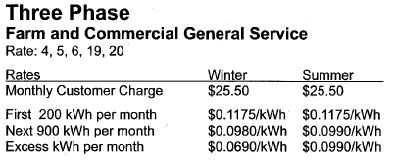So the meter is kind of taking the average? Average is 156.6 amps. 240 * 156.6 * 1.732 * 0.8 / 1000 = 52 KW/h ----------------------52 * $0.07 = $3.64 per hour
Wow 7 cents a KWh is low for a commercial or industrial service, as well as no peek demand? PF penalties?
Our utility is second highest in the nation and for just a residential service we are over 16 cents a KWH with it going up if we use over 700 KWH's a month to about 23 cents a KWH, I think Com ED is the highest.
My best suggestion is to get actual billings for this place as no kind of measurements will be as accurate as using the actual utility bill that you could give a fair estimate on, using a two year billing cycle and finding a yearly average then break it down to weeks days and even hours if this is needed which can be allot more accurate as the meter measures the correct KWH that flows through it, even if all the load was on one or two phases just like a gas pump at a service station, there are no averaging from one phase to another if it measures 400 watts on A 200 on B and 300 on C it will record 900 watts of usage per hour, no state utility board would ever allow any less accurate method of electrical usage, but if you look at the actual utility bill you will find many other charges such as demand and PF as well as delivery, and some might charge for line maintenance, so actual charges will vary for many reasons, and if the loads change hour to hour day to day as well as off times such as weekends and nights if the operation is not a 24/7 plant, being that this is a farm the utility could be charging some special rate and maybe even giving farms a break.
The way I was shown was to take the lowest amp reading * 240 * 1.732 *.8 with will give you the KW of the balanced load across the three phase, take away this current from the two higher phases and calculate the results of the lowest of these to phases at the 240 volt and just the .8 PF, then take away the lowest current of these two phases from the highest and calculate this current at 120 volts and the .8 pf
Heres an example, lets say you have 40 amps on A, 20 amps on B and 30 amps on C
20 * 240 * 1.732 * .8 = 6650.9 watts
taking away the 20 amps from A and C give you 20 on A and 10 on C will give you 10 amps on both @ 240 volts single phase.
so 10 * 240 * .8 = 1920 watts
this leaves 10 watts on A @ 120 volts
10 8 120 8 .8 = 920 watts
so 6650.9 + 1920 + 920 = 9490.9 total watts that the meter recorded?
Is this the correct way, well it made sense when I was told this method but I'm not sure if it is the correct way and if it is exactly how the meter will record it?
But as you can see just taking an average between all three phases you end up with 9976.32 watts which does error just about 500 watts higher so both methods are close.
But the main problem with either of these methods will be the sample rate and actual load diversity , as the current can vary over time and unless you know exactly how long each load runs over a given amount of time the error ratio can go up or down, I have seen people try to guesstimate how much there bill will be by taking current readings on single phase services and still have a 40% error when they get their bill because they don't realize how much load diversity plays a very big part in how the bill comes out, and trying to put down a figure that could come back and bite you when the customer gets a much larger bill or less? lets say they are wanting this info to claim on tax's and it comes in short, they might try to get the differance from your liability insurance

